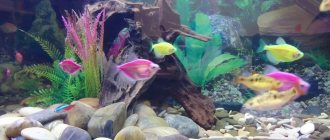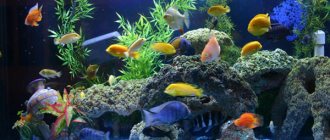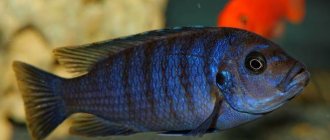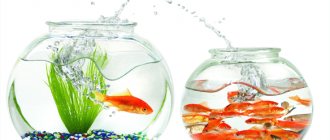It's finally summer! The sun is shining brighter and more cheerfully every day, and even I am losing my working mood (and I am a well-known workaholic). Some of you, my dears, are already packing their bags for the dacha and for trips abroad, others are in a hurry to purchase materials for repairs.
We have already agreed with a hotel for Sharik and Murzik, and this time the rodents were lucky with their summer vacation. At least you can take them all with you. But where should we put the fish? They don’t need rest in the sun, but you don’t want to leave them hungry in the dark either. You can float it to your neighbors or sell it... But they live so well, they are not happy about the move, and their health may suffer from this relocation.
Approaching the topic of our conversation today, it’s worth remembering all the smart articles about the proper keeping of fish and caring for an aquarium. A well-established and properly operated mechanism rarely fails, even in moments when it is not given attention for a long time. Aquarium biology is a delicate thing, but nature knows how to adapt (for a while) to new conditions. Still, attentive and caring aquarium owners are concerned about going on vacation.
Let's look at these burning questions without panic, so to speak, on the eve of the hot (hopefully) summer days.
How can the fish remain without food for a week or a month?
For a week, if they are not predators, it is quite possible to leave them without food. There shouldn't be any problems here. It is believed that fish can easily tolerate two to three weeks of fasting without harm to their general condition (in the presence of rich vegetation, and for a longer period). But if it’s more, then automatic feeders and timers (for turning on the lights, for example) will save you. Automatic feeders, as a rule, operate on two AA batteries and have a feed tank designed for an average of 14-24 days of feeding a 200-liter aquarium. In the program you can set from 1 to 4 feedings per day. The installation and operating principles of the automatic feeder are simple, accessible to anyone, even a “non-technical” person. An automatic feeder is installed on top of the aquarium. Feeding is carried out by rotating the feed tank. The tank has an adjustable hole through which the food spills out, there is a regulator for increasing and decreasing the window in the tank (you can set the portion of food). Most importantly, do not forget to install and adjust it the day before departure. From my own experience, I know that food in the form of confetti or chips is best suited for an automatic feeder. It is convenient due to the same size of feed particles. The feeding time and the number of rotations of the feed tank during feeding can be programmed. Please note that there are 2 main types of automatic feeders - mechanical and electronic. They all operate on batteries, the difference is that the mechanical drum with food rotates at a clockwise speed, which means its nozzle is open above the surface of the aquarium for at least 5-10 minutes. This is quite enough for the evaporation of heated aquarium water to turn the food inside it into glue, which, when covered with mold, becomes toxic when it gets into the aquarium or completely seals the automatic feeder. In any case, the fish will be unhappy. The electronic feeder rotates quickly and prevents the food from absorbing moisture. A set of batteries lasts for up to three months. It is advisable to put new batteries in the automatic feeder when leaving for a long time.
There are also weekend foods. During short-term departures (no more than two weeks), they will come in handy. They are capsules containing food granules of various sizes. Pay attention to the packaging, it says what size and type of fish they are suitable for. In aquarium water, shell capsules (the most common form for these foods) gradually dissolve, releasing some food. One shell, gradually dissolving in water, supplies food for up to 15 medium-sized fish in a 40 liter aquarium for 10-14 days (at a neutral pH value). This food is suitable for most tropical fish and goldfish. It is available in three types: with regular, planktonic or granular food. To properly dissolve the capsules, water movement is necessary. I copied the composition of one of these foods from one of the packages of a popular manufacturer (food with this composition can also be fed to “children”).
Ingredients: Calcium sulfate, salt, fish meal, ground corn, shrimp meal, soy flour, whole wheat meal, brewer's yeast, fish protein concentrate, wheat germ meal, wheat gluten, dehydrated alfalfa meal, natural flavor, extract from crayfish in soybean oil, L-ascorbyl-2-polyphosphate (source of vitamin C), vitamin premix (vitamin A, vitamin D3, vitamin E, vitamin B12, riboflavin, niacin, calcium pantothenate, vitamin K, folic acid, pyridoxine hydrochloride , thiamine mononitrate, d-biotin), iron oxide, betaine, choline chloride, canfaxanthin, ethoxydine (as a preservative). Of course, it’s difficult to call such feeding a complete daily diet, but it’s still better than nothing. Just don’t turn off the filter and, just in case, leave the compressor on.
What should be done to prevent the inhabitants from eating each other in the absence of food?
Almost all species of fish eat their young or fish much smaller in size. This is a completely natural behavior for them, which has been developing for decades. Therefore, it is advisable to place fish of the same size in the same aquarium.
Another solution to the problem could be to move the aggressor to another container for the duration of the fast. However, there is a problem that after returning to their native aquarium, the large fish will begin to perceive the small ones as food. Therefore, it is not recommended to go on a long hunger strike in an aquarium with different sized fish.
The proper functioning of the aquarium depends primarily on the person, so you should carefully approach the organization of feeding and caring for its inhabitants during the period of absence. The best solution would be to purchase a special feeder or have someone from your family and friends look after the fish.
Other interesting articles
- Varieties of aquarium fish The number of varieties of aquarium fish is in the thousands, and each of them has its own characteristics. Agile and...
- What fish can live without aeration, air in the aquarium? What fish can survive without oxygen and filtration? No living creature can live without...
- How many times a day to feed cichlids in an aquarium Contrary to popular belief, not all cichlids are omnivores. The diet of these active aquarium fish differs significantly...
How will fish and plants live without light?
Humanity does not stand still, and technological progress, along with “smart” houses, also comes up with “smart” things for our little brothers. A timer is the answer to this question; it will make everything seem much easier (and not only during vacation). They come in two types: electromechanical and electronic with a liquid crystal display. An electromechanical relay consists of a box with a disk with a time scale. The time scale is divided into divisions of 15 minutes. The scale disk gradually rotates clockwise. Divisions can be in two states: pressed or released. When pressed, there is light, when pressed, there is no light. Using the switch on the relay, you can set the operating mode: constant or according to the clock you set.
Having installed the feeder and timer, you can safely go on vacation.
Rule three: nutritional balance
The vast majority of fish can eat both live and dry food. A rare peaceful fish will refuse a portion of bloodworms, a rare predator will remain indifferent to granules or flakes. Therefore, it is most often recommended to feed mixed:
- Dry balanced mixtures are a source of microelements, carbohydrates, vitamins, and fiber. They always contain plant components: algae, rich in iodine, calcium, pigment to maintain color;
- Live food: fresh and frozen - bloodworms, tubifex, pollock, shrimp. Source of fats and proteins. It is convenient to freeze bloodworms in thin slices or small lumps of the required volume. In specialized stores, bloodworms, peeled and divided by size (small, medium, large) can be found already frozen. It is very comfortable.
How to feed mixed? It is correct to alternate these feeds: for example, live on even days, and dry on odd days. Or by day of the week, if you stick to a fasting day.
What if the summer is very hot?
From my own experience, I can say that the best results (during long departures) are obtained by a separate method of maintenance during the vacation period. Fishes separately, plants separately. Fish, as you know, do not need light, but plants have a hard time without it.
It's 30 degrees outside, the temperature in the aquarium is critical, what should I do? The first step is to turn off the lights and install a compressor with several spray points (or one long sprayer) so that the oxygen is distributed evenly throughout the aquarium. Plants also suffer due to high temperatures, but this is a rhetorical question. Who cares what? Again, from personal experience I will say that it is possible to revive plants that have endured high temperatures, but to revive a boiled fish...
So what to do? Separate the fish and plants into different aquariums (do not forget that the fish should not be kept in the aquarium like herrings in a barrel). Place a lamp with a timer over the plants (under no circumstances should plants be exposed to a window or exposed to sunlight), and leave the fish with the filter, compressor and automatic feeder on.
Frequently asked questions and wise answers
How long can you go without feeding your fish? – If you want to see your pets healthy and happy, a maximum of one or two days. One day is useful, two is a stretch, three is already dangerous for their health. Don't forget: you are a fish god. It is possible to live without food for several days, but if you are going on vacation or a business trip, entrust your pets to someone responsible, and do not torture the animals.
What to feed catfish and should you feed them? - Of course it is necessary. Catfish, even those that in their free time scrape plaque from the walls and click like snail nuts, need special nutrition. Watch the fish feed. If the catfish actively turns on during dinner and receives its portion of bloodworms or granules, then you don’t have to give anything additional. Such stories are the lot of aquariums with a small number of calm fish. If:
- In the aquarium there are large catfish (Anzstrus, Pterygoplicht, etc.);
- There are many inhabitants in the aquarium (regardless of peaceful or predatory fish);
- The basis of the fish’s diet is flakes,
in this case, you need separate food for catfish. Either lower the food to the bottom with tongs and wait for the catfish to take it, or give special tablets that immediately fall to the bottom.
What to do if the fish refuse to eat? – This situation can arise in three cases:
- Pisces get sick;
- The food is of poor quality;
- The food is not suitable.
The tactics are simple:
- Fish out food;
- Observe the fish: do they have spots, do they itch against objects, do they swim smoothly, etc. Record any deviations in behavior and consult with a specialist;
- If the problem is the wrong food, simply replace it with another one. Again, to avoid guessing, you can consult or read information about your pet.
Fish fight for food: what to do? – it might be worth increasing the volume a little. They don’t have enough food in one serving. There are weak or “modest” fish. As a result of natural selection, such representatives may soon die of hunger, since stronger neighbors will not give them enough food. But you are a fish god! Organize feeding so that the weak will definitely get food: for example, give him a separate small portion on tongs. It’s better not to drive away the strong: they don’t need stress either. Another solution is to move the weak ones to another aquarium.
The fish held a bloodworm in its mouth and spat it out. This is fine? - Certainly. Everyone has their own eating habits. The main thing is that she does not spit out all the food. See if she eats.
The fish have eaten, but look hungry. Give me more? - No! In most cases, you just think the fish are hungry. They won't touch the extra portion, and you'll have to fish it out. Some (for example, goldfish) simply do not know when to stop and will eat as much as they are given.
Do you need a special feeder? - Not necessary. The remaining food will still have time to settle to the bottom, and an extra object floating on the surface is an extra object for cleaning. However, sometimes you still need devices: tongs, separate feeders, etc.
What are the dangers of overfeeding? - oddly enough, the same as for humans: obesity, lethargy, physical inactivity and early death.
What are the dangers of underfeeding? – gastrointestinal diseases, shortened life expectancy, weakened immunity.
How and how much to feed the fry? – babies are fed in a special way. At first, many have a yolk sac, which they feed on for the first few days. If the parents do not care for the offspring, and the yolk sac has run out or was not there, they are fed with Cyclops, coretra, Artemia nauplii, live dust, and daphnia. The main thing is that the food fits into the tiny mouth. At home, fry are not always born in a spawning tank; it is difficult to additionally feed them in a general aquarium. Therefore, natural selection most often decides here.
I heard that live food is dangerous. Why? – Only low-quality food is dangerous. Like any thing that is placed in water, the food must be cleaned. Bloodworms may contain bacteria and parasites. You can only buy live food from trusted sellers, in which case it will be absolutely safe. This can be difficult for beginners, so it's best to look for a ready-made freezer.
The second danger of live food is that it may become spoiled. This happens if you freeze it many times, keep it warm for a long time, or store it incorrectly. Therefore, you can safely freeze everything that is frozen, dividing it into portions first.
How to do a water change? After all, everyone has left
You can stop weekly water changes and running around with buckets not only during vacation (although you shouldn’t get carried away with this). But perhaps no chemistry can replace your hard work and keen eye. During the holidays, this problem is more acute than ever; here you still have to negotiate with friends or neighbors. Just don’t burden them with instructions on how to pump out water, but instead give them the treasured bottle of a special drug that helps establish and maintain biological balance. With it you can maintain “order” in the aquarium for up to 6 months. All that remains is to persuade them to come to you once a week and pour a certain dose into the aquarium, as well as top up the evaporated water. As a rule, if there have been no maintenance problems in your aquarium throughout the year, then its inhabitants should not suffer during the holidays.
Rule four: delicacies
This is the kind of fish food that you shouldn't give them every day, but you can spoil them, so to speak, from time to time. But not everyone can or needs this. Before stocking up on treats, check with breeders, hobbyists, or fish keepers at a pet store to see if this is worth it. It is better not to give any delicacies than to give something that will kill the fish.
What to feed to pamper your pets:
- Scalded lettuce, zucchini, cucumber - recommended for carnivores who consume few dry mixtures;
- Scalded beef heart, pieces of beef - some large cichlids love it;
- Shrimp are a favorite food of stingrays and largemouth predators. The shrimp must first be defrosted;
- Small bloodworms and grindals can become a treat for peaceful fish whose diet is based on dry food.
In addition, for lovers of living vitamins, you can create beds of Wolffia and other nutritious plants. Some aquarists specifically create a separate aquarium for growing them.
What if the fish get sick?
There can only be one piece of advice here. Refrain from buying fish less than a month before your vacation. If there is some kind of infection in the fish, then it will most likely manifest itself within a month. If your new resident gets sick, then three to four weeks is enough to cure him and put him in full combat readiness. Well, if due to circumstances or other reasons the purchase took place, then it is best to leave the new fish in a separate quarantine aquarium, then in case of illness the infection will not spread to the old-timers.
Advertising
Is it safe to leave running appliances plugged in?
This is a serious question, but it must be approached philosophically. In ten years of working with pumps, heaters and other aquarium trinkets, not a single one of them has shorted out in the socket, and certainly not caused a natural disaster. Perhaps, all problems, if they may arise, are only due to the fault of the “Chinese” extension cords, from which the plugs fall out, or rotten wiring (which would also be a good idea to look at before leaving). Check the contacts on the lamp (especially with incandescent lamps), check the reliability of the chokes and the integrity of the terminals on the lamps. Remove unnecessary debris (such as food packaging and other flammable pieces of paper) from under the lamp (from the cover glass). Check the cords of the equipment for integrity of the wires, and go safely “to the south”, relax and gain strength.
What should you do after returning from a trip?
Firstly (if this happens), remove dead fish or rotten plant leaves from the aquarium. Remove weekend feed. Wipe the walls of the aquarium, wash the filter. Make a partial water change, but do not try to immediately (as many people like to do) replace all the water in the aquarium. This makes sense, but a sudden change in water will cause stress for the fish. Therefore, first change 25-30 percent, do not forget to add anti-stress supplements. And then, if you feel itchy, then calmly, a week in advance, prepare the water and quietly, without unnecessary hassle, sort through the “jar.”
That's probably all the procedures. Until next time!
Article provided by the website “Zoo Price”
How to prepare residents for a hunger strike?
If there is a need to leave the aquarium unattended for some time, you need to fully prepare it for your absence.
A week before departure, you should thoroughly clean the aquarium, rinse the filter, check the water temperature and the operation of all aquarium equipment. You should also make sure the health of its inhabitants.
A few days before the hunger strike, you should increase the amount of food, and a few days later gradually reduce it so that it is easier for the fish to tolerate its absence. It should be remembered that the smaller the fish, the more it needs feeding. Therefore, small fish can fast for a maximum of a couple of days. If you are planning a long trip, then it is better to purchase an automatic feeder or find someone who will monitor the aquarium while you are away.











